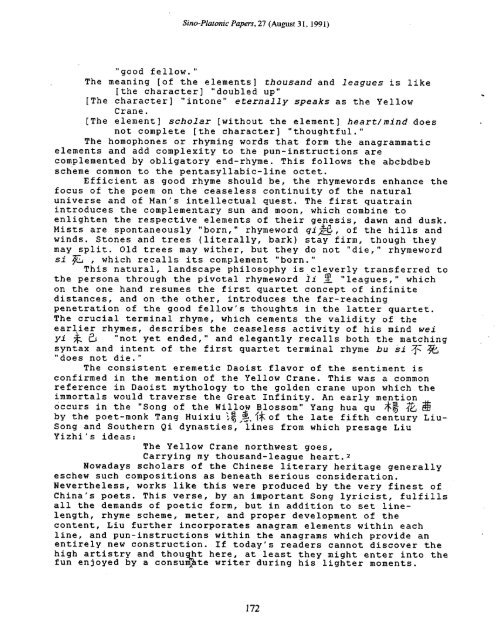Essays on Writing and Language in Honor - Sino-Platonic Papers
Essays on Writing and Language in Honor - Sino-Platonic Papers
Essays on Writing and Language in Honor - Sino-Platonic Papers
You also want an ePaper? Increase the reach of your titles
YUMPU automatically turns print PDFs into web optimized ePapers that Google loves.
S<strong>in</strong>o-Ph<strong>on</strong>ic <strong>Papers</strong>, 27 (August 3 1, 199 1)<br />
"good fellow. "<br />
The mean<strong>in</strong>g [of the elements] thous<strong>and</strong> <strong>and</strong> leagues is like<br />
[the character] "doubled up"<br />
[The character] "<strong>in</strong>t<strong>on</strong>e" eternally speaks as the Yellow<br />
Crane.<br />
[The element] scholar [without the element] heart/m<strong>in</strong>d does<br />
not complete [the character] "thoughtful."<br />
The homoph<strong>on</strong>es or rhym<strong>in</strong>g words that form the anagrammatic<br />
elements <strong>and</strong> add complexity to the pun-<strong>in</strong>structi<strong>on</strong>s are<br />
complemented by obligatory end-rhyme. This follows the abcbdbeb<br />
sch'eme comm<strong>on</strong> to the pentasyllabic-l<strong>in</strong>e octet.<br />
Efficient as good rhyme should be, the rhymewords enhance the<br />
focus of the poem <strong>on</strong> the ceaseless c<strong>on</strong>t<strong>in</strong>uity of the natural<br />
universe <strong>and</strong> of Man's <strong>in</strong>tellectual quest. The first quatra<strong>in</strong><br />
<strong>in</strong>troduces the complementary sun <strong>and</strong> mo<strong>on</strong>, which comb<strong>in</strong>e to<br />
enlighten the respective elements of their genesis, dawn <strong>and</strong> dusk.<br />
M i s t s are sp<strong>on</strong>taneously "born," rhymeword qiB, of the hills <strong>and</strong><br />
w<strong>in</strong>ds. St<strong>on</strong>es <strong>and</strong> trees (literally, bark) stay firm, though they<br />
may split. Old trees may wither, but they do not "die," rhymeword<br />
si , which recalls its complement "born."<br />
This natural, l<strong>and</strong>scape philosophy is cleverly transferred to<br />
the pers<strong>on</strong>a through the pivotal rhymeword li 2 "leagues, " which<br />
<strong>on</strong> the <strong>on</strong>e h<strong>and</strong> resumes the first quartet c<strong>on</strong>cept of <strong>in</strong>f<strong>in</strong>ite<br />
distances, <strong>and</strong> <strong>on</strong> .the other, <strong>in</strong>troduces the far-reach<strong>in</strong>g<br />
penetrati<strong>on</strong> of the good fellow's thoughts <strong>in</strong> the latter quartet.<br />
The crucial term<strong>in</strong>al rhyme, which cements the validity of the<br />
earlier rhymes, describes the ceaseless activity of his m<strong>in</strong>d wei<br />
yi & 5 "not yet ended," <strong>and</strong> elegantly recalls both the match<strong>in</strong>g<br />
syntax <strong>and</strong> <strong>in</strong>tent of the first quartet term<strong>in</strong>al rhyme bu ii 5 a<br />
"does not die."<br />
The c<strong>on</strong>sistent eremetic Daoist flavor of the sentiment is<br />
c<strong>on</strong>firmed <strong>in</strong> the menti<strong>on</strong> of the Yellow Crane. This was a comm<strong>on</strong><br />
reference <strong>in</strong> Daoist mythology to the golden crane up<strong>on</strong> which the<br />
immortals would traverse the Great Inf<strong>in</strong>ity. An early menti<strong>on</strong><br />
dccurs <strong>in</strong> the "S<strong>on</strong>g of the Willow Blossom" Yang hua qu $8<br />
by the poet-m<strong>on</strong>k Tang Huixiu \g ,$, {& of the late fifth century Liu-<br />
S<strong>on</strong>g <strong>and</strong> Southern Qi dynasties, l<strong>in</strong>es from which presage Liu<br />
Yizhi's ideas: The Yellow Crane northwest goes,<br />
Carry<strong>in</strong>g my thous<strong>and</strong>-league hearte2<br />
Nowadays scholars of the Ch<strong>in</strong>ese literary heritage generally<br />
eschew such compositi<strong>on</strong>s as beneath serious c<strong>on</strong>siderati<strong>on</strong>.<br />
Nevertheless, works like this were produced by the very f<strong>in</strong>est of<br />
Ch<strong>in</strong>a's poets. This verse, by an important S<strong>on</strong>g lyricist, fulfills<br />
all the dem<strong>and</strong>s of poetic form, but <strong>in</strong> additi<strong>on</strong> to set l<strong>in</strong>e-<br />
length, rhyme scheme, meter, <strong>and</strong> proper development of the<br />
c<strong>on</strong>tent, Liu further <strong>in</strong>corporates anagram elements with<strong>in</strong> each<br />
l<strong>in</strong>e, <strong>and</strong> pun-<strong>in</strong>structi<strong>on</strong>s with<strong>in</strong> the anagrams which provide an<br />
entirely new c<strong>on</strong>structi<strong>on</strong>. If today's readers cannot discover the<br />
high artistry <strong>and</strong> thou ht here, at least they might enter <strong>in</strong>to the<br />
fun enjoyed by a c<strong>on</strong>subte writer dur<strong>in</strong>g his lighter moments.<br />
8

















